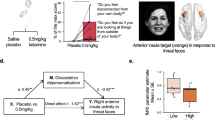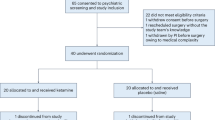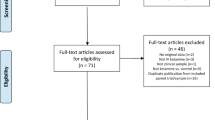Abstract
Many patients with social anxiety disorder (SAD) experience inadequate symptom relief from available treatments. Ketamine is a potent N-methyl-D-aspartate receptor antagonist with a potentially novel mechanism of action for the treatment of anxiety disorders. Therefore, we conducted a double-blind, randomized, placebo-controlled crossover trial in 18 adults with DSM-5 SAD and compared the effects between intravenous ketamine (0.5 mg/kg over 40 min) and placebo (normal saline) on social phobia symptoms. Ketamine and placebo infusions were administered in a random order with a 28-day washout period between infusions. Ratings of anxiety were assessed 3-h post-infusion and followed for 14 days. We used linear mixed models to assess the impact of ketamine and placebo on anxiety symptoms. Outcomes were blinded ratings on the Liebowitz Social Anxiety Scale (LSAS) and self-reported anxiety on a visual analog scale (VAS-Anxiety). We also used the Wilcoxon signed-rank test to compare the proportion of treatment responders. Based on prior studies, we defined response as a greater than 35% LSAS reduction and 50% VAS-Anxiety reduction. We found ketamine resulted in a significantly greater reduction in anxiety relative to placebo on the LSAS (Time × Treatment: F9,115=2.6, p=0.01) but not the VAS-Anxiety (Time × Treatment: F10,141=0.4, p=0.95). Participants were significantly more likely to exhibit a treatment response after ketamine infusion relative to placebo in the first 2 weeks following infusion measured on the LSAS (33.33% response ketamine vs 0% response placebo, Wilcoxon signed-rank test z=2.24, p=0.025) and VAS (88.89% response ketamine vs 52.94% response placebo, Wilcoxon signed-rank test z=2.12, p=0.034). In conclusion, this proof-of-concept trial provides initial evidence that ketamine may be effective in reducing anxiety.
Similar content being viewed by others
Log in or create a free account to read this content
Gain free access to this article, as well as selected content from this journal and more on nature.com
or
References
Abdallah CG, Averill LA, Collins KA, Geha P, Schwartz J, Averill C et al (2016). Ketamine treatment and global brain connectivity in major depression. Neuropsychopharmacology 42: 1210–1219.
Aitken RC (1969). Measurement of feelings using visual analogue scales. Proc R Soc Med 62: 989.
Barnes L, Harp D, Jung WS (2002). Reliability generalization of scores on the Spielberger state-trait anxiety inventory. Educ Psychol Meas 62: 603–618.
Berman RM, Cappiello A, Anand A, Oren DA, Heninger GR, Charney DS et al (2000). Antidepressant effects of ketamine in depressed patients. Biol Psychiatry 47: 351–354.
Bloch MH, Wasylink S, Landeros-Weisenberger A, Panza KE, Billingslea E, Leckman JF et al (2012). Effects of ketamine in treatment-refractory obsessive-compulsive disorder. Biol Psychiatry 72: 964–970.
Bremner JD, Krystal JH, Putnam FW, Southwick SM, Marmar C, Charney DS et al (1998). Measurement of dissociative states with the Clinician-Administered Dissociative States Scale (CADSS). J Trauma Stress 11: 125–136.
Carreno F, Donegan J, Boley A, Shah A, DeGuzman M, Frazer A et al (2015). Activation of a ventral hippocampus–medial prefrontal cortex pathway is both necessary and sufficient for an antidepressant response to ketamine. Mol Psychiatry 21: 1298–1308.
Cella DF, Perry SW (1986). Reliability and concurrent validity of three visual-analogue mood scales. Psychol Rep 59: 827–833.
Davey HM, Barratt AL, Butow PN, Deeks JJ (2007). A one-item question with a Likert or Visual Analog Scale adequately measured current anxiety. J Clin Epidemiol 60: 356–360.
Domi E, Uhrig S, Soverchia L, Spanagel R, Hansson AC, Barbier E et al (2016). Genetic deletion of neuronal PPARγ enhances the emotional response to acute stress and exacerbates anxiety: an effect reversed by rescue of amygdala PPARγ function. J Neurosci 36: 12611–12623.
Donahue RJ, Muschamp JW, Russo SJ, Nestler EJ, Carlezon WA (2014). Effects of striatal ΔFosB overexpression and ketamine on social defeat stress-induced anhedonia in mice. Biol Psychiatry 76: 550–558.
Dwyer JB, Beyer C, Wilkinson ST, Ostroff RB, Qayyum Z, Bloch MH (2017). Ketamine as a treatment for adolescent depression: a case report. J Am Acad Child Adolescent Psychiatry 56: 352–354..
Feder A, Parides MK, Murrough JW, Perez AM, Morgan JE, Saxena S et al (2014). Efficacy of intravenous ketamine for treatment of chronic posttraumatic stress disorder: a randomized clinical trial. JAMA Psychiatry 71: 681–688.
Freitas-Ferrari MC, Hallak JE, Trzesniak C, Santos Filho A, Machado-de-Sousa JP, Chagas MHN et al (2010). Neuroimaging in social anxiety disorder: a systematic review of the literature. Prog Neuropsychopharmacol Biol Psychiatry 34: 565–580.
Glue P, Medlicott NJ, Harland S, Neehoff S, Anderson-Fahey B, Le Nedelec M et al (2017). Ketamine’s dose-related effects on anxiety symptoms in patients with treatment refractory anxiety disorders. J Psychopharmacol 0269881117705089. doi:10.1177/0269881117705089; e-pub ahead of print.
Gould TD, Zanos P, Zarate CA (2017). Ketamine mechanism of action: separating the wheat from the chaff. Neuropsychopharmacology 42: 368–369.
Hamilton M (1960). A rating scale for depression. J Neurol Neurosurg Psychiatry 23: 56–62.
Heimberg RG, Horner K, Juster H, Safren S, Brown E, Schneier F et al (1999). Psychometric properties of the Liebowitz social anxiety scale. Psychol Med 29: 199–212.
Ionescu DF, Luckenbaugh DA, Niciu MJ, Richards EM, Slonena EE, Voort JLV et al (2014). Effect of baseline anxious depression on initial and sustained antidepressant response to ketamine. J clin psychiatry 75: 932–938.
Johnson MP, Barda D, Britton TC, Emkey R, Hornback WJ, Jagdmann GE et al (2005). Metabotropic glutamate 2 receptor potentiators: receptor modulation, frequency-dependent synaptic activity, and efficacy in preclinical anxiety and psychosis model (s). Psychopharmacology (Berl) 179: 271–283.
Kelly JM, Jakubovski E, Bloch MH (2014). Prognostic subgroups for remission and response in the Coordinated Anxiety Learning and Management (CALM) trial. J clin psychiatry 76: 267–278.
Kessler R (2003). The impairments caused by social phobia in the general population: implications for intervention. Acta Psychiatr Scand 108: 19–27.
Kessler RC, Chiu WT, Demler O, Walters EE (2005). Prevalence, severity, and comorbidity of 12-month DSM-IV disorders in the National Comorbidity Survey Replication. Arch gen psychiatr 62: 617–627.
Kishimoto T, Chawla JM, Hagi K, Zarate CA, Kane JM, Bauer M et al (2016). Single-dose infusion ketamine and non-ketamine N-methyl-d-aspartate receptor antagonists for unipolar and bipolar depression: a meta-analysis of efficacy, safety and time trajectories. Psychol Med 46: 1459–1472.
Krystal JH, Sanacora G, Duman RS (2013). Rapid-acting glutamatergic antidepressants: the path to ketamine and beyond. Biol Psychiatry 73: 1133–1141.
Laje G, Lally N, Mathews D, Brutsche N, Chemerinski A, Akula N et al (2012). Brain-derived neurotrophic factor Val66Met polymorphism and antidepressant efficacy of ketamine in depressed patients. Biol Psychiatry 72: e27.
Liebowitz MR (1987). Social phobia. Mod Prob Pharmacopsychiatry 22: 141–173.
Liebowitz MR, DeMartinis NA, Weihs K, Londborg PD, Smith WT, Chung H et al (2003). Efficacy of sertraline in severe generalized social anxiety disorder: results of a double-blind, placebo-controlled study. J Clin Psychiatry 64: 785–792.
Liebowitz MR, Hanover R, Draine A, Lemming R, Careri J, Monti L (2016). Effect of as‐needed use of intranasal PH94B on social and performance anxiety in individuals with social anxiety disorder. Depress Anxiety 33: 1081–1089.
Lipsitz JD, Schneier FR (2000). Social phobia. Pharmacoeconomics 18: 23–32.
Liu R-J, Duman C, Kato T, Hare B, Lopresto D, Bang E et al (2016). GLYX-13 produces rapid antidepressant responses with key synaptic and behavioral effects distinct from ketamine. Neuropsychopharmacology 42: 1231–1242.
Maeng S, Zarate CA Jr (2007). The role of glutamate in mood disorders: results from the ketamine in major depression study and the presumed cellular mechanism underlying its antidepressant effects. Curr psychiatry rep 9: 467–474.
McGowan JC, LaGamma CT, Lim SC, Tsitsiklis M, Neria Y, Brachman RA et al (2017). Prophylactic ketamine attenuates learned fear. Neuropsychopharmacology 42: 1577–1589.
Mennin DS, Fresco DM, Heimberg RG, Schneier FR, Davies SO, Liebowitz MR (2002). Screening for social anxiety disorder in the clinical setting: using the Liebowitz Social Anxiety Scale. J Anxiety Disord 16: 661–673.
Milak M, Proper C, Mulhern S, Parter A, Kegeles L, Ogden R et al (2015). A pilot in vivo proton magnetic resonance spectroscopy study of amino acid neurotransmitter response to ketamine treatment of major depressive disorder. Mol Psychiatry 21: 320–327.
Murrough JW (2016). Ketamine for depression: an update. Biol Psychiatry 80: 416–418.
Murrough JW, Iosifescu DV, Chang LC, Al Jurdi RK, Green CE, Perez AM et al (2013a). Antidepressant efficacy of ketamine in treatment-resistant major depression: a two-site randomized controlled trial. Am J Psychiatry 170: 1134–1142.
Murrough JW, Perez AM, Pillemer S, Stern J, Parides MK, aan het Rot M et al (2013b). Rapid and longer-term antidepressant effects of repeated ketamine infusions in treatment-resistant major depression. Biol Psychiatry 74: 250–256.
Niciu MJ, Henter ID, Luckenbaugh DA, Zarate CA Jr, Charney DS (2014). Glutamate receptor antagonists as fast-acting therapeutic alternatives for the treatment of depression: ketamine and other compounds. Annu Rev Pharmacol Toxicol 54: 119–139.
Peris TS, Compton SN, Kendall PC, Birmaher B, Sherrill J, March J et al (2015). Trajectories of change in youth anxiety during cognitive–behavior therapy. J Consult Clin Psychol 83: 239.
Phan KL, Fitzgerald DA, Cortese BM, Seraji-Bozorgzad N, Tancer ME, Moore GJ (2005). Anterior cingulate neurochemistry in social anxiety disorder: 1H-MRS at 4 Tesla. Neuroreport 16: 183–186.
Pollack MH, Jensen JE, Simon NM, Kaufman RE, Renshaw PF (2008). High-field MRS study of GABA, glutamate and glutamine in social anxiety disorder: response to treatment with levetiracetam. Prog Neuropsychopharmacol Biol Psychiatry 32: 739–743.
Ribeiro L, Busnello JV, Cantor RM, Whelan F, Whittaker P, Deloukas P et al (2007). The brain-derived neurotrophic factor rs6265 (Val66Met) polymorphism and depression in Mexican-Americans. Neuroreport 18: 1291.
Rodriguez CI, Kegeles LS, Levinson A, Feng T, Marcus SM, Vermes D et al (2013). Randomized controlled crossover trial of ketamine in obsessive-compulsive disorder: proof-of-concept. Neuropsychopharmacology 38: 2475–2483.
Roy-Byrne P, Craske MG, Sullivan G, Rose RD, Edlund MJ, Lang AJ et al (2010). Delivery of evidence-based treatment for multiple anxiety disorders in primary care: a randomized controlled trial. Jama 303: 1921–1928.
Salvadore G, Cornwell BR, Colon-Rosario V, Coppola R, Grillon C, Zarate CA et al (2009). Increased anterior cingulate cortical activity in response to fearful faces: a neurophysiological biomarker that predicts rapid antidepressant response to ketamine. Biol Psychiatry 65: 289–295.
Sanacora G, Heimer H, Hartman D, Mathew S, Frye M, Nemeroff C et al (2016). Balancing the promise and risks of ketamine treatment for mood disorders. Neuropsychopharmacology 42: 1179–1181.
Spielberger CD . Manual for the State-Trait Anxiety Inventory STAI (form Y)(‘self-evaluation questionnaire’). Mind Garden: Palo Alto, CA, 1983.
Taylor JH, Jakubovski E, Bloch MH (2015). Predictors of anxiety recurrence in the Coordinated Anxiety Learning and Management (CALM) trial. J Psychiatr Res 65: 154–165.
Taylor JH, Lebowitz ER, Silverman WK . Anxiety Disorders. In A. Martin, M.H. Bloch, F.R. Volkmar (eds.), Lewis’s child and adolescent psychiatry: A comprehensive textbook. 5th edition. Wolters Kluwer: Philadelphia, PA, 2017a, pp. 509–518..
Taylor JH, Lebowitz ER, Jakubovski E, Coughlin CG, Silverman WK, Bloch MH (2017b). Monotherapy insufficient in severe anxiety? Predictors and moderators in the Child/Adolescent Anxiety Multimodal Study. J Clin Child Adolesc Psychol in press.
Taylor JH, Xu Y, Li F, Shaw M, Dziura J, Caprio S et al (2016). Psychosocial predictors and moderators of weight management programme outcomes in ethnically diverse obese youth. Pediatr Obes. doi:10.1111/ijpo.12165.
Valentine GW, Mason GF, Gomez R, Fasula M, Watzl J, Pittman B et al (2011). The antidepressant effect of ketamine is not associated with changes in occipital amino acid neurotransmitter content as measured by [1 H]-MRS. Psychiatry Res Neuroimag 191: 122–127.
Walker DL, Davis M (2002). The role of amygdala glutamate receptors in fear learning, fear-potentiated startle, and extinction. Pharmacol Biochem Behav 71: 379–392.
Williams VS, Morlock RJ, Feltner D (2010). Psychometric evaluation of a visual analog scale for the assessment of anxiety. Health qual life outcomes 8: 57.
Zarate CA, Singh JB, Carlson PJ, Brutsche NE, Ameli R, Luckenbaugh DA et al (2006). A randomized trial of an N-methyl-D-aspartate antagonist in treatment-resistant major depression. Arch Gen Psychiatry 63: 856–864.
Zimmerman M, Martinez JH, Young D, Chelminski I, Dalrymple K (2013). Severity classification on the Hamilton depression rating scale. J Affect Disord 150: 384–388.
Acknowledgements
The authors gratefully acknowledge support from the Robert E. Leet and Clara Guthrie Patterson Trust (JHT, AL-W, MHB), National Institutes of Health/National Institute of Mental Health (NIH/NIMH, 5T32MH018268, 5T32MH19961, 5T32MH019112, JHT; 1K23MH091240, MHB) and NARSAD (MHB). Additionally, the LSAS is a copyrighted scale, and we thank Michael Lebowitz, MD for allowing us to use the scale free of charge. ClinicalTrials.gov Identifier: NCT02083926
Author information
Authors and Affiliations
Corresponding author
Additional information
Supplementary Information accompanies the paper on the Neuropsychopharmacology website
Supplementary information
Rights and permissions
About this article
Cite this article
Taylor, J., Landeros-Weisenberger, A., Coughlin, C. et al. Ketamine for Social Anxiety Disorder: A Randomized, Placebo-Controlled Crossover Trial. Neuropsychopharmacol. 43, 325–333 (2018). https://doi.org/10.1038/npp.2017.194
Received:
Revised:
Accepted:
Published:
Issue date:
DOI: https://doi.org/10.1038/npp.2017.194
This article is cited by
-
Ketamine-induced altered states of consciousness: a systematic review of implications for therapeutic outcomes in psychiatric practices
European Archives of Psychiatry and Clinical Neuroscience (2025)
-
Ketamine in neuropsychiatric disorders: an update
Neuropsychopharmacology (2024)
-
Oral ketamine may offer a solution to the ketamine conundrum
Psychopharmacology (2023)



